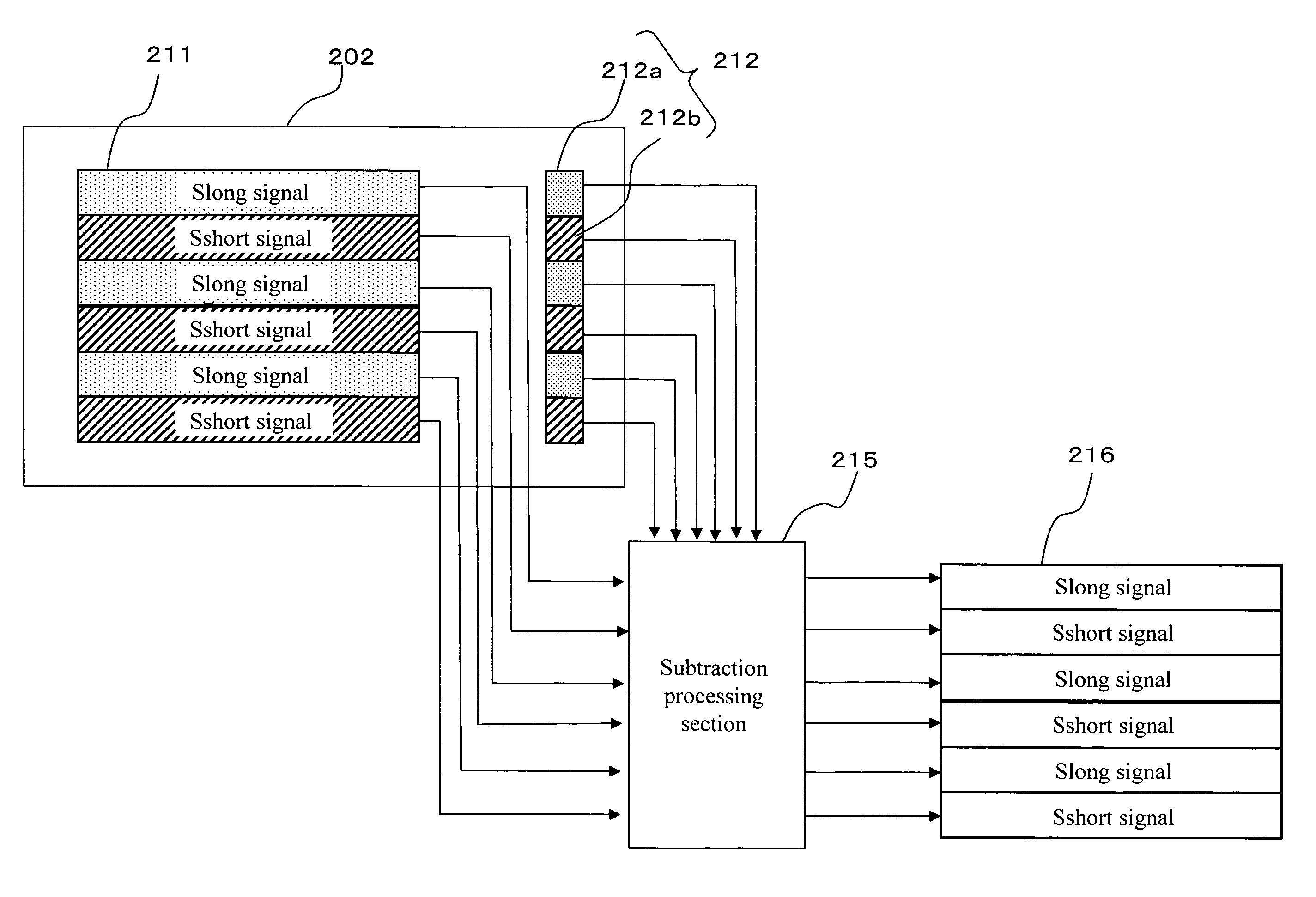Method for reading out signal charges from an image sensor having different exposure times
a signal charge and image sensor technology, applied in the field of image sensors, can solve the problems of difficult to achieve clear image depiction of images (objects), limited incident light quantity of these area sensors, etc., and achieve the effect of expanding the dynamic range and suppressing the deterioration of picture quality
- Summary
- Abstract
- Description
- Claims
- Application Information
AI Technical Summary
Benefits of technology
Problems solved by technology
Method used
Image
Examples
first embodiment
[0077]FIG. 1 is a schematic diagram of a solid-state image pickup device that comprises an MOS image sensor according to a first embodiment of the present invention. The solid-state image pickup device comprises an MOS image sensor 101, a drive control section 102 for drive-controlling the image sensor 101, and a signal processing section 103 for processing the signal from the image sensor 101.
[0078]FIG. 2 is a block diagram showing the detailed structure of the image sensor 101. In FIG. 2, reference numeral 201 indicates an image pickup element, and 202 is an area sensor. Reference numeral 203 is a vertical shift register that functions as a vertical control section, and 204 is a reset shift register that functions as a reset control section. Reference numeral 205 is a reset mask control section, 206 is a signal charge readout control section, and 207 is a horizontal shift register. The vertical shift register 203, the reset shift register 204, the reset mask control section 205, a...
second embodiment
[0116]FIG. 6A shows Bayer-type color filter array 210. The Bayer-type color filter array 210 is an example of a filter array that corresponds to the color filters based on three primary colors of the light (red, green, blue). In the Bayer-type color filter array 210, G pixel that is the main signal of the luminance signal requiring high resolution is indicated as pixel Gr and pixel Gb, and these pixels Gr and Gb are arranged alternately in the pixel array area of lattice pattern while providing a space of one pixel between them. Then, pixel R and pixel B are arranged alternately in those spaces.
[0117]In the Bayer-type color filter array 210, four pixels (2×2) of pixel Gr, pixel Gb, pixel R, and pixel B constitute a base unit. In the area sensor 202 having the Bayer-type color filter arrays 210, the color filter arrays 210 are arranged in an orderly manner.
[0118]As shown in FIG. 6B, in an exposure area 211 of the area sensor 202, there are set the first line pair consisting of the od...
third embodiment
[0129]A third embodiment of the present invention will be described referring to FIG. 8. The third embodiment is distinctive in terms of the processing of a subtraction processor 215. The long exposure signal Slong is supplied to the subtraction processor 215 from an OB pixel section 212a located on the first line pair. Further, the short exposure signal Sshort is supplied to the subtraction processor 215 from an OB pixel section 212b located on the second line pair. The long exposure signal Slong and the short exposure signal Sshort are supplied separately to the subtraction processing section 215.
[0130]The subtraction processing section 215 separately processes the output signals (the long exposure signal Slong, the short exposure signal Sshort) of the OB pixel sections 212a and 212b. That is, the subtraction processing section 215 separately and individually samples the output signals of each of the OB pixel sections 212a, 212b to generate the OB components that respectively corr...
PUM
 Login to View More
Login to View More Abstract
Description
Claims
Application Information
 Login to View More
Login to View More - R&D
- Intellectual Property
- Life Sciences
- Materials
- Tech Scout
- Unparalleled Data Quality
- Higher Quality Content
- 60% Fewer Hallucinations
Browse by: Latest US Patents, China's latest patents, Technical Efficacy Thesaurus, Application Domain, Technology Topic, Popular Technical Reports.
© 2025 PatSnap. All rights reserved.Legal|Privacy policy|Modern Slavery Act Transparency Statement|Sitemap|About US| Contact US: help@patsnap.com



